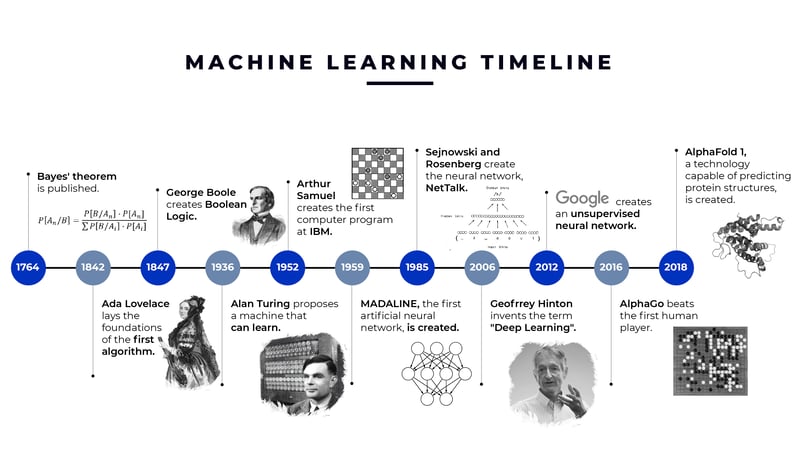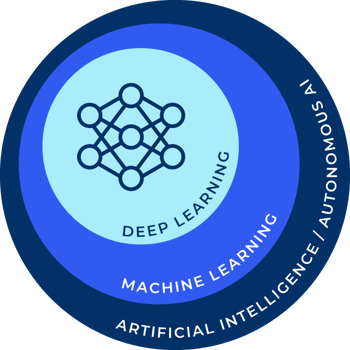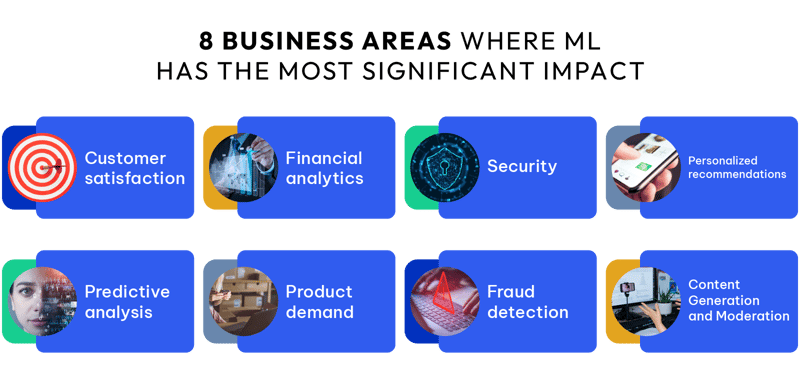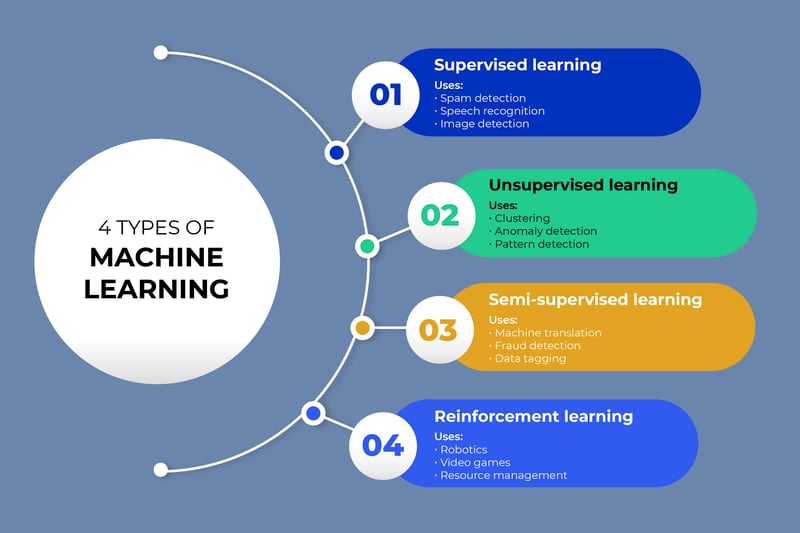
Machine Learning: What is ML and how does it work?
Machine Learning (ML) is a branch of AI and autonomous artificial intelligence that allows machines to learn from experiences with large amounts of data without being programmed to do so. It synthesizes and interprets information for human understanding, according to pre-established parameters, helping to save time, reduce errors, create preventive actions and automate processes in large operations and companies.
This article will address how ML works, its applications, and the current and future landscape of this subset of autonomous artificial intelligence.
Table of contents
- What is the importance of Machine Learning?
- How Machine Learning has evolved?: The History of ML
- Difference between AI, Machine Learning and Deep Learning
- 8 Business areas where ML has the most significant impact
- 4 Machine Learning models
- Pros and cons of Machine Learning
- The future of Machine Learning
What is the importance of Machine Learning?
The importance of Machine Learning (ML) lies in its accelerated capacity to recognize patterns, correct errors, and deliver results in complex and highly accelerated processes with thousands and thousands of data.
This is crucial nowadays, as many organizations have too much information that needs to be organized, evaluated, and classified to achieve business objectives. This has led many companies to implement Machine Learning in their operations to save time and optimize results.
In addition, Machine Learning is a tool that increases productivity, improves information quality, and reduces costs in the long run.
How has Machine Learning evolved? The History of ML
Despite its rise in popularity in the last years, Machine Learning is not a new tool. It has been around for centuries, at least theoretically.
From Thomas Bayes, who in the 18th century laid the foundations of statistics to develop this technology, to the creation of AlphaGo, the first machine to beat a human opponent in the famous game Go, Machine Learning has grown along with humanity.
Here is a brief timeline of the most important events in the history of machine learning:

If you want to learn more about the history of Artificial Intelligence, Machine Learning, and Deep Learning, read our full article here.
Difference between AI, Machine Learning, and Deep Learning
Autonomous artificial intelligence, AI, Machine Learning, and Deep Learning are inseparable from each other.
 That is, they are all concentric subsets of AI and autonomous AI. One could not exist without the other. While AI is the basis for processing data and creating projections, Machine Learning algorithms enable AI to learn from experiences with that data, making it a smarter technology.
That is, they are all concentric subsets of AI and autonomous AI. One could not exist without the other. While AI is the basis for processing data and creating projections, Machine Learning algorithms enable AI to learn from experiences with that data, making it a smarter technology.
Deep Learning heightens this capability through neural networks, allowing it to generate increasingly autonomous and comprehensive results.
8 Business areas where ML has the most significant impact
Inside professional organizations, Machine Learning has its greatest impact mainly in these areas:
1. Customer Satisfaction
In addition, Machine Learning algorithms have been used to refine data collection and generate more comprehensive customer profiles more quickly.
2. Financial Analytics
Using Machine Learning in the financial services industry is necessary as organizations have vast data related to transactions, invoices, payments, suppliers, and customers.
3. Security
A key use of Machine Learning is storage and access recognition, protecting people's sensitive information, and ensuring that it is only used for intended purposes.
With the help of Machine Learning, cloud security systems use hard-coded rules and continuous monitoring. They also analyze all attempts to access private data, flagging various anomalies such as downloading large amounts of data, unusual login attempts, or transferring data to an unexpected location.
In the same way, Machine Learning can be used in applications to protect people from criminals who may target their material assets, like our autonomous AI solution for making streets safer, vehicleDRX.
4. Personalized Recommendations
One of the most well-known uses of Machine Learning algorithms is to recommend products and services depending on the data of each user, or even suggest productivity tips to collaborators in various organizations.
The most substantial impact of Machine Learning in this area is its ability to specifically inform each user based on millions of behavioral data, which would be impossible to do without the help of this technology.
5. Predictive analysis
Machine Learning has proven to be a necessary tool for the effective planning of strategies within any company thanks to its use of predictive analysis.
Due to their ability to learn from previous experiences and their access to databases from all around the world, computers and software enhanced with Machine Learning can extrapolate, with a small margin of error, several data related to a company’s activities and their potential future scenarios. This can include predictions of possible leads, revenues, or even customer churns. Taking these into account, the companies can plan strategies to better tackle these events and turn them to their benefit.
6. Product demand
Product demand is one of the several business areas that has benefitted from the implementation of Machine Learning.
Thanks to the assessment of a company’s past and current data (which includes revenue, expenses, or customer habits), an algorithm can forecast an estimate of how much demand there will be for a certain product in a particular period. This provides the company with valuable information such as how much money and resources they should allocate toward that product, both for its production and for its marketing, which ultimately helps to reduce risks and to make certain that the demand will be met accordingly.
7. Fraud detection
As a tool, the Internet has helped businesses grow by making some of their tasks easier, such as managing clients, making money transactions, or simply gaining visibility. However, this has also made them target fraudulent acts within their web pages or applications. Machine Learning has been pivotal in the detection and stopping of fraudulent acts.
Enhanced with Machine Learning, certain software can help identify the patterns of behavior of a business’ customer and send a flag whenever they go outside of their expected behavior. This goes from something simple like the kind of card they use when buying something online to their IP data or the usual value of their transactions they make.
A parameter is established, and a flag is triggered whenever the customer exceeds the minimum or maximum threshold set by the AI. This has proven useful to many companies to ensure the safety of their customers’ data and money and to keep intact the business’s reliability and integrity.
8. Content Generation and Moderation
Machine Learning has also helped companies promote stronger communication between them and their clients. This can be done through content generation and content moderation.
For example, an algorithm can learn the rules of a certain language and be tasked with creating or editing written content, such as descriptions of products or news articles that will be posted to a company’s blog or social media. On the other hand, the use of automated chatbots has become more common in Customer Service all around the world. These chatbots can use Machine Learning to create better and more accurate replies to the customer’s demands.
Finally, an algorithm can be trained to help moderate the content created by a company or by its users. This includes separating the content into certain topics or categories (which makes it more accessible to the users) or filtering replies that contain inappropriate content or erroneous information.

4 Machine Learning Models
Machine Learning is composed of 4 main models.
These models work based on a set of labeled information that allows categorizing the data, predicting results out of it, and even making decisions based on insights obtained. The appropriate model for a Machine Learning project depends mainly on the type of information used, its magnitude, and the objective or result you want to derive from it. The four main Machine Learning models are supervised learning, semi-supervised learning, unsupervised learning, and reinforcement learning.
Their main difference lies in the independence, accuracy, and performance of each one, according to the requirements of each organization.
1. Supervised learning
Through supervised learning, the machine is taught by the guided example of a human.
The machine is fed a large set of data, which then is labeled by a human operator for the ML algorithm to recognize. If the algorithm gets it wrong, the operator corrects it until the machine achieves a high level of accuracy. This task aims to optimize to the point the machine recognizes new information and identifies it correctly without human intervention.
This type of ML model works very well to perform a specific task. It can be found in several popular applications such as spam detection, digital ads analytics, speech recognition, and even image detection.
2. Unsupervised learning
Unsupervised learning is the opposite of supervised learning: there are no human-determined labels.
Instead, this algorithm is given the ability to analyze data features to identify patterns. Contrary to supervised learning there is no human operator to provide instructions. The machine alone determines correlations and relationships by analyzing the data provided. It can interpret a large amount of data to group, organize and make sense of. The more data the algorithm evaluates over time the better and more accurate decisions it will make.
Some of the applications that use this Machine Learning model are recommendation systems, behavior analysis, and anomaly detection.
3. Semi-supervised learning
This type of ML model combines the two previous approaches. The algorithm can be fed with training data, but it can also explore this data and develop its own understanding of it. It is characterized by generating predictive models that perform better than those created from supervised learning alone.
This model works best for projects that contain a large amount of unlabeled data but need some quality control to contextualize the information. This model is used in complex medical research applications, speech analysis, and fraud detection.
4. Reinforcement learning
This system works differently from the other models since it does not involve data sets or labels.
This type of Machine Learning model learns from its mistakes. It works through an agent placed in an unknown environment, which determines the actions to be taken through trial and error. Its objective is to maximize a previously established reward signal, learning from past experiences until it can perform the task effectively and autonomously. This type of learning is based on neurology and psychology as it seeks to make a machine distinguish one behavior from another.
Reinforcement learning can be found in video games, industrial simulations, robotics, and resource management.

Pros and Cons of Machine Learning
While there are great benefits to Machine Learning, it also has some risky aspects.
Because Machine Learning learns from past experiences, and the more information we provide it, the more efficient it becomes, we must supervise the processes it performs. It is essential to understand that ML is a tool that works with humans and that the data projected by the system must be reviewed and approved.
In the same way, we must remember that the biases that our information may contain will be reflected in the actions performed by our model, so it is necessary to take the necessary precautions.
Advantages of Machine Learning
- Recognition of specific patterns: It helps develop products and services based on particular consumer demands and profiles.
- Automation of responses: This allows people to focus on other areas, leaving the system to make the best decision in different scenarios.
- Acceleration of results: Because Machine Learning models are trained to achieve specific results, it is possible to reach them faster, replicating behaviors with proven success.
Disadvantages of using Machine Learning
- Inaccessible to many: Machine Learning can be expensive. It is a tool that needs a specific timeframe to learn and adapt, but it provides great long-term benefits.
- Exclusion in data: ML algorithms may exclude specific populations. We must remember that they learn based on information provided by humans, which may contain biases.
- A high degree of specialization is needed: Machine Learning is a specialized tool few people understand. Currently, a data scientist is needed to implement Machine Learning, but this will surely change in the future.
What is the future of Machine Learning?
It is expected that Machine Learning will have greater autonomy in the future, which will allow more people to use this technology.
Companies such as Amazon, Google, and Facebook have made important contributions to developing Machine Learning and will surely continue to do so for many years to come. This technology has allowed hundreds of companies to improve brand loyalty, increase sales, reduce costs, and perform processes in less time.
Did you know that you use Machine Learning in your daily life? Find out more in our 5 Machine Learning examples article.
If you want to learn more about how this technology works, we invite you to read our complete autonomous artificial intelligence guide or contact us directly to show you what autonomous AI can do for your business.